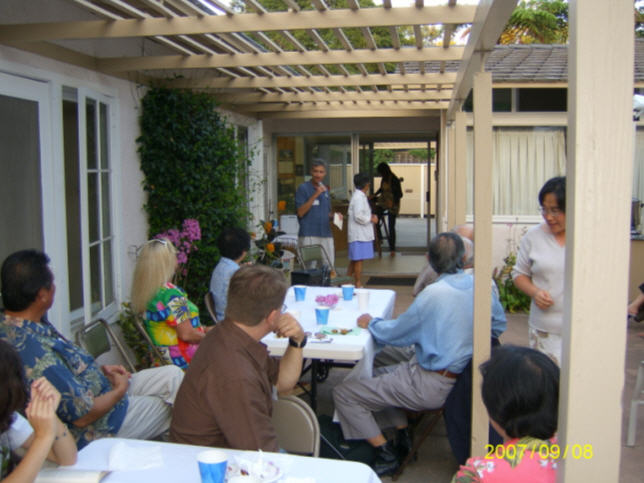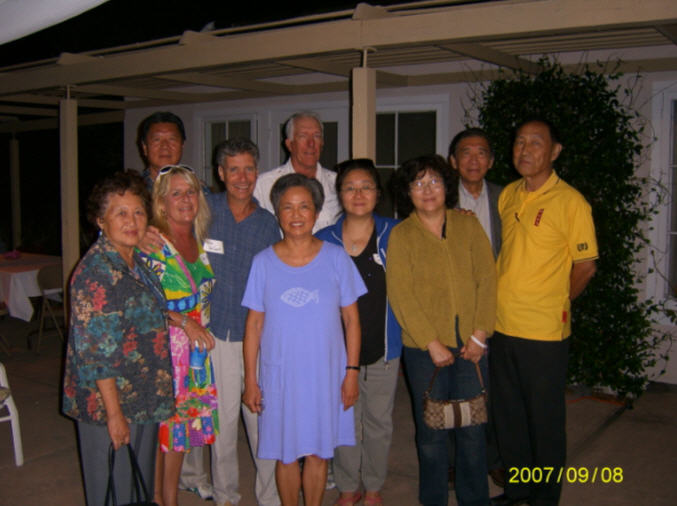At the APHAFIC summer poolside party, 42 APHFIC members and friends participated. After delicious Chinese buffet, all listened to an informative talk by Mr. Aaron De Groot about his trip to China in June. Aaron De Groot was among 10 high school history teachers who participated in the 2007 US Teachers Institute tour accompanied by GA officials from June 25-July 10. This project was to enhance the teachers’ understanding of the culture and historical background of China during the Asia-Pacific war in 1931-1946. Accompany ten teachers, were two moviemakers, a Holocaust-genocide education specialist from United Kingdom, and a human rights activist were on this trip. All four non-teachers and three GA delegates (i.e. Peter Li, Ignatius and Josephine Ding) were self-funded. Each of the ten teachers was funded by a local GA chapter.
Their first stop was Shanghai, where they visited the museum for comfort women. They were the first group of foreigners to visit this museum. 200,000 to 400,000 women were victimized during WWII. In a four-hour meeting, the group met with one of the comfort women from Hainan. They were moved to tears by her story; and gave her standing ovation.
This kind of museum was not funded by the Chinese government. Instead, funds were contributions from private parties and international organizations. The Chinese government does not seem to be dedicated to preserving WWII history.
Nanking is the next stop. 2007 is the 70th anniversary of the Rape of Nanking. That city also has a museum, and all its signs are in Chinese only. Aaron would like to see English translations added to the exhibits in the museum.
Aaron met Grandma Sha, who was a victim of the rape of Nanking on 12/14/1937. She survived, along with four of her siblings, but the rest of her family was killed by the Japanese. A Japanese author called her “the liar of Nanking” for telling the truth about the massacre, so she sued him in a Japanese court. He did not show up to defend his words.
Next stop is Yiwu, where DoLittle’s pilots parachuted after bombing Tokyo. All the American pilots were saved by the local Chinese. Japanese retaliated with biological warfare in that area, setting up the infamous Unit 731. Aaron met a Mr. Wu, who lost seven to nine family members to the biological warfare.
At Shanghai International Conference, Aaron met other groups of people who have been participating in finding out the truth about the Japanese invasion of China. The groups came from Britain and Canada.
In Hubei Province Aaron met POWs and civilians who served as slave labor during the war. These people were put to work with little food. The Japanese soldiers didn’t care whether the slaves lived or died.
Aaron visited Plum Blossom Village, where a small-scale “Nanking Massacre” happened. Drawings on walls depict the efforts of unarmed civilians against armed Japanese soldiers.
The group also visited other parts of the country, such as the Great Wall, Tiananmen Square, Forbidden City, etc.
Aaron’s travel group included teachers of different backgrounds. Ages ranged from 20 to over 70. Everyone was touched by the stories they heard on this trip, and came back a changed person.
Aaron would like to help make more people will learn about these atrocities. He will tell his stories to students. He will be involved in Global Alliance, perhaps helping to recruit educators to send on future GA trips to China.

The teacher’s group in front of the Tunnel War Memorial Museum
at Jiao Zhuang Hu,outside of Beijing
http://www.bjwmb.gov.cn/zt/zt_aiguo/jiaozhuanghu.htm
http://bj.sina.com.cn/art/2005-03-29/67840.shtml
Mr. Aaron De Groot talked about his trip to China

my and Aaron De Groot (third and fourth from left) with APHAFIC board members after the meeting